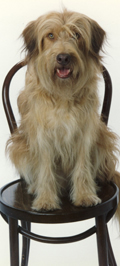| |
Some trainers have criticized luring, stating that, dogs are trained “better” if they have not been lured. This, of course, is learning theory heresy. Behavior is consequence-driven, not antecedent-driven. A dog is not trained better depending on whether she was lured or not. If she’s trained, she’s trained, and if not, she’s not.
In pet dog training, there is an endless quest for the quickest, easiest, most enjoyable and most expedient route to produce equipment-free and gizmo-free, off-leash, response-reliability. The choice of training technique has a huge influence on “time and trials to criterion.” As by far the quickest, and one of the simplest of all training techniques, lure/reward training is the technique of choice for most owners to teach their dog basic manners.
Whereas trainers have a little more leeway in choosing a technique for teaching basic manners, for behavior modification and temperament training, food lure/reward training should be mandatory. There is some extreme urgency to prevent and resolve behavior problems. Behavior problems, such as housesoiling, destructive chewing, and excessive barking, kill dogs. Without a doubt, simple behavior problems are the number one terminal illness for pet dogs. Time is of the essence. Similarly, biting, fighting, and fearful dogs are hardly happy, or safe to be around. Consequently, there is simply no time to mess around with time-consuming techniques. We must resolve the dogs’ problems, relieve their chronic (yet acute) stress levels, and improve their quality of life by using the most time-efficient and enjoyable methods available.
Other techniques are championed in other specialist training fields, wherein the syllabus is finite and the trainer knows the rules and questions (criteria) before the test or trial and especially, when time is not an issue. Knowledgeable, experienced, and dedicated handlers will train for hours to perfect a desired behavior. However, pet dog training differs markedly from teaching competition or working dogs, from training marine mammals, and from computers autoshaping rats and pigeons in laboratories. With pet dog training, the questions are unknown and the syllabus is infinite—comprising all aspects of a dog’s (and owner’s) behavior, temperament, and training. But the most important difference—owners are not dog trainers; they seldom have a trainer’s education, interest, dedication, experience, or expertise.
Trainers should never underestimate their own expertise. Characteristically, techniques that we recommend for owners to train their dogs are entirely different (easier, quicker, and less complicated) than techniques that we might use to train our own dogs.
A comprehensive lure/reward training program comprises five stages:
- Teaching The Dog What We Want Him To Do
- Teaching The Dog To Want To Do What We Want Him To Do
- Enforcing Compliance Without Fear Or Force
- Refining Performance Precision And Pizzazz
- Protecting Performance Reliability And Precision
The first three steps focus on establishing response reliability and are all-important in all fields of dog training. In Stage 1, training lures are phased out completely (within a dozen trials) and replaced with hand or verbal lures (handsignals and requests/commands). In Stage 2, training rewards are phased out and replaced with life rewards (a la Premack). Eventually, the cued response becomes self-reinforcing as the dog becomes internally motivated. In a sense, “just doing it” becomes the biggest reward in dogdom. In Stage 3, a reliable cued response is enforced without force, fear, or pain. The final two Stages—for refining precision and for protecting precision and reliability—are primarily for obedience, working, and demo dogs and will only be summarized.
|



